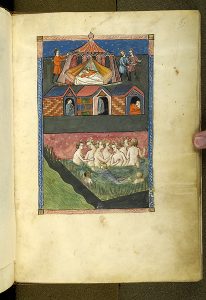This week, I speak with Dr. Lucy Barnhouse, a professor of medieval history at Arkansas State University. We chat about the physical space of the medieval hospital before discussing theoretical systems of care available to medieval residents, and consider how the medieval relationship to public and community health connect to our current struggle with COVID-19.
Listen here.
Overview
As we discuss in this episode, medieval public health as a paradigm is often overlooked in the landscape of public health as a whole. With medieval science in general, and public health in particular, there is a tendency to assume medieval people did not care for their bodies or care about their health. This assumption has been reinforced by pop culture and post-medieval scholarship for centuries, despite being untrue– medieval people had complex understandings of their own bodies and health, and how their well-being was intertwined with the health of their neighbors, friends, and surroundings. (And yes, they did take baths.)

As Dr. Barnhouse points out, this kind of thinking obscures the lived reality of many people who sought care in the medieval period: not only were treatments often evidence-based, hospitals also considered an individual’s surroundings as a key component of their overall health. Some medieval hospitals incorporated green spaces, large windows, and other quality of life improvements, and provided palliative care for all kinds of people– even those who were seriously ill, or whose stays stretched on for long periods of time.
Furthermore, the concept of hospitality under which hospitals were organized emphasized the necessity of caring for the sick directly, irrespective of their condition– even if, like leprosy, it was potentially contagious. This paradigm also meant medieval people did not pay for their hospital stays (turns out Medicare for All is more medieval than we realized).
Whether you’re a historian of public health like Lucy, or any kind of researcher of medieval science (hello!), you’ll agree that it’s crucial to remember that medieval hospitals housed real people, with complex relationships to the systems providing them with care. In this episode, we discuss some of the records we do possess of residents’ experiences in medieval hospitals, as well as what recent investigations into medical care can tell us about medical experiences in the absence of personal narratives.
Recommended Reading
Hospitals and Public Health
As a general introduction to medieval public health, Carol Rawcliffe’s Urban Bodies investigates the medieval city as a whole, considering how the medieval hospital fit into the body of a larger system– and late medieval attempts to “clean up” the city in service of public health.
If you’re looking for a history of the medieval hospital, Dr. Tiffany Ziegler’s Medieval Healthcare and the Rise of Municipal Institutions scrutinizes the medieval hospital as an example of institutional care, and tracks its development throughout the Middle Ages.
Dr. Adam J. Davis’s The Medieval Economy of Salvation discusses theological imperatives for the creation of hospitals, and how their development in the twelfth and thirteenth century affected expectations around charitable donations and spiritual gain.
Pandemics, etc.
Moving on to perhaps the most recognizable public health event of the medieval period, Dr. Monica H. Green’s work on the Black Plague and medieval medicine in general gives especially important context to the social and political ramifications of a multi-generational outbreak. The Global History Podcast episode with Dr. Green on global disease history, available here, is one place to start, as is the essay collection she edited, Pandemic Disease in the Medieval World: Rethinking the Black Death.
Her critical bibliography of Black Death scholarship, edited with Joris Roosen, is available through google docs: “The Mother of All Pandemics: The State of Black Death Research in the Era of COVID-19 – Bibliography.“
On breakdowns of stereotypes about leprosy, this upcoming collection looks to be an excellent start: Leprosy and Identity in the Middle Ages.
Here’s a fully-digitized twelfth-century collection of medical recipes, BL Sloane MS 2839, which may have been used as a textbook, from the British Library via the Polansky digitization project.
And another manuscript, a set of medical treatises by Marcus Empiricus (BL Arundel MS 166).
Finally, we must recommend the biweekly podcast on which Dr. Barnhouse is a co-host, called “Footnoting History”. It discusses under-examined historical events in bite-sized episodes, including but certainly not limited to . You can find the show here, and we’ve rounded up a few choice episodes below:
- on the humors and remedies for common illnesses, hosted by Lucy
- a particularly timely episode about an early modern plague
- medieval conspiracy theories?!?

Dr. Guy Geltner writes about the dangers of periodizing the COVID-19 pandemic in this blog post for History News Network.
And in a cross-period context, Dr. Eleanor Janega wrote this post about comparisons between COVID-19 and the plague which helpfully breaks down the differences between plague (disease) and the Black Plague (a particular outbreak) and speaks to some of the more recent interest in medieval public health.
Everything Else
The category of medieval public health is impossibly vast, but if you’d like to look further into medieval medical paradigms, or if you just like weird medical pictures, look below.